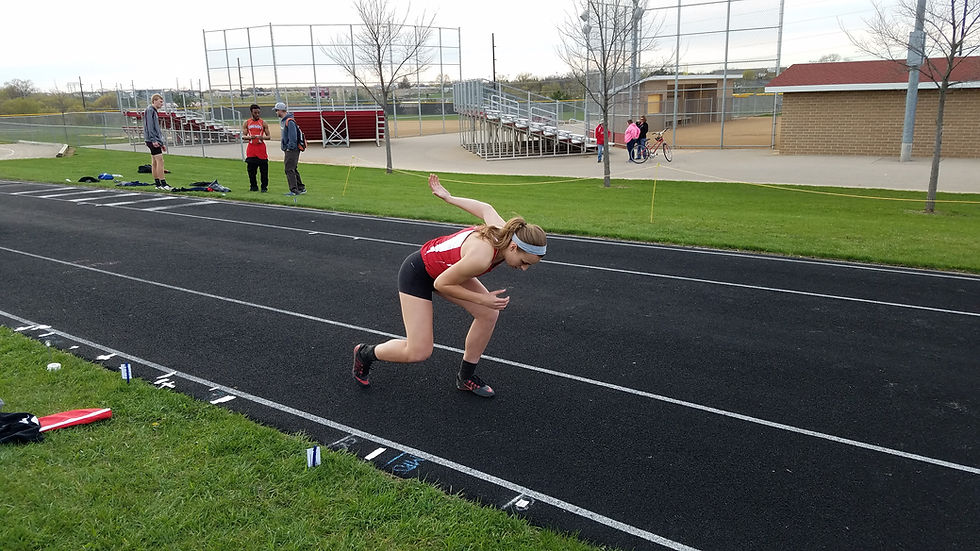Day 8 - 2019
- Coach Ewing
- Mar 12, 2019
- 4 min read
Today was an "X-factor" day for our sprinters/explosion-athletes. This means that athletes were put through a large number of conditioning and mechanics-focused movements and drills.
On days like this, I like to get in as much "pounding" as possible. I don't mean this in the old school way of making every kid run a mile for the heck of it, but in a conditioning way. The pounding that happens now during the early part of the season prepares their body for the extreme amount of stress it will encounter when the competition season begins.
So, we started off with a triple jump practice today. Veterans built upon their work from last week and began connecting the proper leg rotations of the first phase with the step phase. I inched the 2nd hurdle (watch video) out a bit to challenge them more on PUSHING properly for distance on the hop phase to ensure they made the step phase hurdle.
Side note - DON'T tell kids to try for a "home run" hop phase unless they are ready to do so. When I was inching out the 2nd hurdle, I was doing so with a great amount of observation. Had my jumpers started to lose proper posture and/or control I would have put the hurdle back to a manageable spot. DON'T RUSH THIS PART OF TRIPLE TRAINING!
Now back to practice...
The new triple jumpers were split into two groups. Ones that worked on triple jump last week were asked to work on the hop phase with some moderate speed. Last week, they worked on the hop phase only with very little speed (which is how it should be taught to new jumpers - don't add speed until ready). The kids that were new to triple were asked to follow the same progression and simply focused on the hop phase non-jump leg rotation with no speed.
Directly after triple jump was completed I worked with all sprint athletes on the "X-factor" (progression) drills that I planned for today. Last week, I had athletes perform a double-legged jump to a soft plyo box that was followed by a depth jump with an "athletic landing". Simply put, athletes were supposed to land the depth jump athletically (knees bent, chest up, etc.) and "freeze". Today, I used what we did last week and made an addition. They performed the two-legged jump to a soft plyo box, performed a depth jump, landed athletically (without freezing this time), and performed a rocket jump.
During the offseason I read a large number of athletic training books/resources. During my time doing that, I realize that I needed to better train my athletes HOW to land and absorb ground contacts better. In so doing, I created the progression we are using for our X-factor days this year. Thus far, the kids have learned how to not only absorb, but also how to use their arms properly to maximize their explosive potential. This is a BIG deal not only in the jumps but also in EVERY OTHER TRACK AND FIELD EVENT! Needless to say, I am very happy with our progression thus far!
Once X-factor was completed, I worked with the "inexperienced" jumpers. We went to a hallway in the school and worked more on the start. As mentioned yesterday, the start is incredibly important. The inexperienced jumpers will spend a great deal of their season working solely on starts. It's a repetition thing, and without large amounts of dedicated focus to the start athletes will simply scratch most of their attempts. To my delight/surprise, the inexperienced kids did a GREAT job on their start mechanics today. There are still some things to work on, but overall I was very please with what I saw!
After the inexperienced jumpers worked on mechanics I introduced them to a drill I call the "Fifth Step Approach Drill". Basically, I want every athlete to be consistent in their first five steps. If they can hit (or get really close to) the same distance each time they attempt a start I feel this directly translates to board at takeoff. Again, I was pleasantly surprised how many kids were hitting their fifth step (or getting close to it). There were a few that were WAY OFF, but overall, the group seemed to really understand the concept and did a great job!
After I was done with the inexperienced jumpers, the veterans got some full out approach work in. I rolled out a tape measure, told them to partner up, and instructed them to get at least 2-4 approaches in so that they could give me some data points to look at. So, each kid partnered up, figured out who would be the "watcher" and the runner, told each other the number of steps they perform (determined yesterday), and went to work. After one athlete performed an approach their partner told them what their number was, and they switched jobs. This continued until most athletes had at least 2 approaches completed.
Running in hallways is extremely different from a runway, but as long as I can get a "rough" number that's all I really care about at this point in the season. We will make more adjustments as time goes on!
TOMORROW:
Another speed day. Will not do more approaches due to them being done the last two days. Will instead focus on the proper takeoff (long jump) and possibly the landing.
.png)


Comments